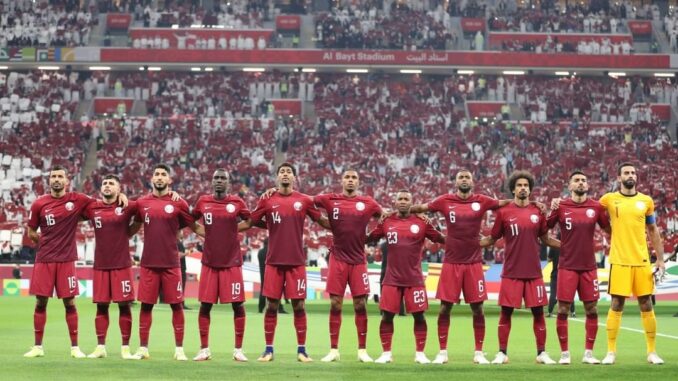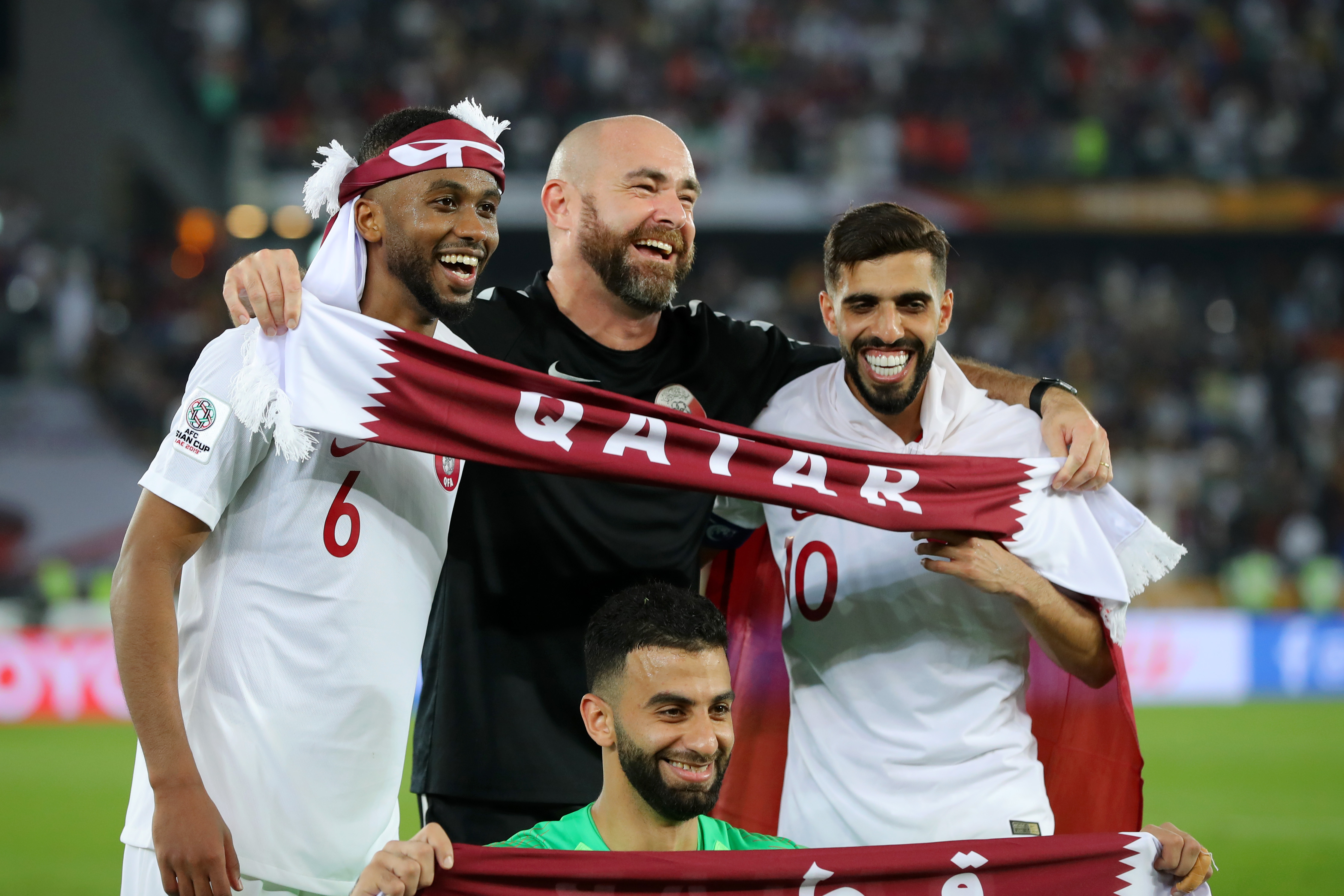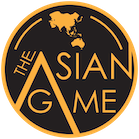

The Asian Game’s coverage of the FIFA World Cup Qatar 2022 is proudly sponsored by SMC.
The starting pistol on Qatar’s road to 2022 was fired nearly 12 years ago, setting off the longest ever lead-in time for a host to prepare for a FIFA World Cup.
From that very moment, back in 2010, the national team’s preparations, alongside the regularly poured over infrastructure and organisational concerns of holding the event itself, have ramped up as somewhat of an afterthought for the world’s attention.
While what materialises in the opener in November can directly trace its origins back to decisions made over a decade ago, it wasn’t always clear what direction the national team would take at the time, setting in motion two quite contrasting routes to form a national team that was intended to make the country proud come 2022.
While there was method initially to their intended approach, consistency has not been one of the hallmarks you’d necessarily affix to Qatari football, at least until recent years.
Over a seven-year period following Sep Blatter immortal words, Qatar ran through no fewer than nine coaches, comprising seven different nationalities before finally settling on the current incumbent Spaniard Felix Sanchez, who has just surpassed his five-year tenure in post.
Progress has rarely been smooth for Qatar, but a lot of what we’ll likely be greeted with at the end of the year will have been set in motion back in 2010. Through the twists and turns of a national team trying to find its way, the highlights and pitfalls will likely come to define their eventual success or failure moving forward.
Eyes of the World
The national team, in its current state, couldn’t resemble a much different outlook than the one that set off on their preparations back in 2010.
Under the late French coach Bruno Metsu, who propelled Senegal to global fame nearly a decade earlier in Korea-Japan 2002, Qatar hosted the AFC Asian Cup in early 2011, with renewed vigour and pressure, with the eyes of the world watching on following their growingly infamous awarding of the World Cup hosting rights, only one month earlier.
Embed from Getty ImagesIt materialised as the first global showcasing of the nation’s footballing future; and they fared quite well.
Making it successfully out of a mediocre looking group, only going out to a last-minute winner against Japan in the quarter-finals, Qatar’s first steps towards 2022 were a relative success; backed up by an adequate, if admittedly not overly impressive (from a global perspective) stadium attendance and a seamless behind-the-scenes running of the event.
The team itself posed the conundrum that would dominate the years to come. Led by the imperious Uruguayan-born turned Qatar Stars League golden boot winner Sebastian Soria, the side were spurred forward by a number of continental quality nationalised imports from around the world, supported by the upcoming generation of local talent intended to form the 2022 backbone of the squad; including former AFC Player of the Year Khalfan Ibrahim, and the prodigious Hassan Al-Haydos.
Away from the national team, assembly of the Aspire Academy was starting to be structured in Doha. An academy built on the very best local and regional talent, aimed in time to support the 2022 national team, if not to ideally form the broad basis of the squad.
As Qatar headed into a new World Cup cycle, on the road to Brazil 2014, the senior national team – led by several key nationalised regional stars – and a growing talent pool at youth level ensured both aspects of the Qatari plan for 2022 were pointing in the same direction; signalling a positive future that opened up the outside possibility that realisation of their global dream could arrive ahead of time.
Back to Reality
The return of World Cup qualification was greeted, however, with predictability. Qatar’s presence as an outsider looking in at the elite of the continent, which has persisted over the last two decades, inevitably continued.
Embed from Getty ImagesWhile successfully making it to the final round of World Cup qualification, their efforts against the very best in Asia were distinctly second rate. Defeats home and away to fellow qualification bridesmaids Uzbekistan, including a particularly emphatic thumping in Tashkent, put paid to any hopes they had of progressing to Brazil and thoughts that they could run before they could walk on the international stage.
With slow progress on the field, the coaches in the dugout were the ones to feel the true impact of mounting expectation of immediate success from up above.
The upsurge in nationalisation from the domestic league, particularly focused on South American mercenaries, didn’t immediately create the desired, cohesive setup many hoped for.
Brazilians Sebastião Lazaroni and Paulo Autuori, in failing to instill the samba style requested by the QFA hierarchy in a quick enough timeframe, felt the wrath of a football federation possibly lacking a little patience and foresight.
The Asian Cup in 2015, now under the leadership of Algerian coach Djamel Belmadi, provided even more bad news for those with one eye on 2022.
Qatar finished dead last in the group stage. Following a heavy opening defeat to regional rivals UAE, and a second sucker punch blow against Iran, Qatar exited as quickly as they entered; to the amusement of their snarky critics observing from afar.
Rather than being a time for reflection and reconsideration, the Asian Cup in Australia only led to further reactive change to recruit yet more overseas-born talent to paper over the cracks of a domestic selection perceived as being significantly behind the levels required.
For years Qatar have been the pioneers of this approach; foregoing the challenges of assembling a competitive squad from such a small population and acutely managing the FIFA eligibility rules to their benefit; undoubtedly a short-term and expensive approach in seeking a competitive edge.
Belmadi deployed six foreign-born players from the start against UAE; a team man-for-man with more expertise than their modest domestic stock, but a team lacking an identity and one that showed little long-term ambition, given their age profile.
The Tipping Point
The next World Cup campaign only built on the nationalisation processes of the past. In their opener, a comfortable victory over Bhutan in 2015, only four of the starters were Qatari-born, and while they breezed through the first round of the competition, the final round again became a telling tale of where they stood against the very best in Asia.
Instead of retreating and accepting their failings, the coaching staff persisted and lobbied for even more nationalisation to take place; underlining its importance to the national team if they were ever going to compete at their home World Cup in 2022.
Uruguayan coach Jorge Fossati even threatened at the time, as the 2018 qualification campaign drew to a close, to resign if the QFA sought to exclude nationalised players from the squad.
“I heard about a plan to exclude naturalised players and bring in more young Qatari players into the national team. It (discouraging naturalisation) is one point I don’t agree with at this stage.
Former Qatar coach Jorge Fossati in 2016
“If the federation wants to go another way, I’ll respect its decision 100 per cent. And it’ll be better for the Qatar national team to have another coach who supports that view.”
Following another premature exit to World Cup qualification, however, separate the two parties did, paving the way for an unequivocal change in selection policy, four years out from their golden moment in the global glare.
The Sanchez Realisation
Following years of frustration and an endless coaching merry-go-round, Qatar were four years away from their World Cup hosting, having failed to establish an identity, approach or even a set of players that we could assume their squad would be built around.
While Plan A – a squad assembled around newly nationalised players who were succeeding in the modest surroundings of the Qatari Stars League – in hindsight unsurprisingly underwhelmed, Plan B – that of focusing on youth honed through the Aspire Academy – was slowly materialising behind the scenes.
Spaniard Felix Sanchez, one of the men brought in at the inception of the Aspire Academy, sought about leading Cohort 2022 through their formative years, from youth football right through to the seniors.
While the QFA undoubtedly hoped they’d unearth a gem or two via this route, the resultant senior squad which is predominantly made up of Aspire graduates was probably something few considered in their wildest of dreams.
This group, led by the precocious talent of flying winger Akram Afif, ball playing centre back Bassam Al-Rawi and the rangy, goal machine Almoez Ali grew together as a unit, slowly improving as a squad, honing their ability and winning continental plaudits.

Continental champions at U19 level in 2014, U20 World Cup qualifiers the following year, and back-to-back semi-final appearances at the U23 Asian Cup in 2016 and 2018, an event dominated by the usual Asian heavyweights of Japan, Korea and Saudi Arabia, Qatar were finally illustrating their commanding performance on the continent, albeit at youth level.
Sanchez’s success was rewarded with the top job in 2017, which would run in tandem initially alongside his existing youth team commitments following Qatar’s failed passage to Russia.
An overnight switch in ideals occurred; Sanchez removed the established order and replaced them with the fledgling players who had brought him such success at youth level, sprinkled with experienced internationals such as the aforementioned Al-Haydos, Algerian-born Boualem Khoukhi and the flexible Pedro Correia, who fit the system and philosophy.
Sanchez replicated the same possession-based approach requested by Aspire, driven by the Spanish philosophy that saw Xavi succeed in his time with QSL giants Al Sadd.
This approach has been continued through to this day. While symbolic and consistent, Sanchez’s unwavering trust in a very tight selection pool, however, has often seen the national team experience the sorts of fluctuations that a club side might go through who haven’t necessarily got the required resources to plunder the transfer market.
Given their past tendencies for trigger happy coaching changes, you’d be right in questioning the QFA’s patience with such a narrow focus. That unbreakable bond, however, can only be explained by the events of one brief month in early 2019.
Qatar become Asian Champions
In the run up to the Asian Cup in 2019 Qatar remained a work in progress, a relative unknown prospect, even within Asia, who were seen to be prematurely putting their trust in young players who’d barely made waves in their domestic league – an environment still monopolised by expensively assembled overseas talent – let alone on the international stage.
Brief glimmers of their potential at senior level only surfaced as Qatar decamped to Europe in late 2018, an approach rarely embraced by Asian international squads at that point; picking up an unexpected draw against Iceland and a similarly eye-catching victory over Switzerland.
The optimism and momentum gained from that brief moment of success continued into their continental campaign in UAE.
Three wins from three in the group stage (a complete reversal from Australia in 2015), Qatar progressed without dropping a point, or conceding a single goal; the turning point being a narrow win over Saudi Arabia, amidst the backdrop of the proxy war of words that had divided the two Gulf states in recent times.
Into the knockouts, confidence continued to grow. A narrow victory over Iraq was followed by a late winner over one of the pre-tournament favourites, the now stifled South Korea, setting up another politically simmering semi-final with hosts UAE.
Despite a barrage of abuse from the stands, including a shower of sandals towards the game’s climax, Qatar’s young talents-turned-overnight stars cruised past a side that had edged out reigning champions Australia only days before.
The final, against Japan no less, was the defining point of the tournament. An early bicycle kick wonder strike by leading man Almoez Ali, who clinched a record ninth goal of the tournament, surpassing the previous best by Iranian great Ali Daei. That was followed by a long-range effort from Abdulaziz Hatem and a late penalty from player of the tournament Akram Afif, either side of a Japanese consolation.
Qatar were champions of Asia – something no one would have predicted at the start of the year.
Embed from Getty ImagesHaving defeated Saudi Arabia, South Korea, UAE and then Japan along the way, they were undisputed champions at that, a surprise package-turned-credible continental giant, all within 30 days.
The QFA were finally justified. After years of investment, tinkering and exasperation, Qatar had established a coach with a vision, a way of winning and a talented pool of talent that could credibly compete on the world stage. The only trouble being it was three years too early.
Building on the Momentum
The resulting three years have had an aspect of anti-climax about them. There have been considerable highs, but significant amounts of frustration and doubt over their World Cup prospects. With such heavy reliance put on the same squad that clinched continental success in 2019, it’s difficult to suggest that this cohort of players has really moved anything forward apart from their age.
Experience is one area that has been broadened. The QFA’s influence, accompanying confederation financial appetite and a COVID pandemic that disincentivised travel for many, brought forward a number of forays outside of the continent.
Fresh off their success in Asia, Qatar entered as a guest participant at 2019’s Copa America, impressing in aspects, as they competed but ultimately lost out to the likes of Colombia and Argentina in the group stages.
In late 2020, Qatar appeared, as the non-official participant, within UEFA European qualification alongside Portugal and Serbia. Following, another promising start, which saw them top the group after the first few matches, realisation soon struck of the distance between themselves and European football’s top tier. There was a clear trend establishing.
The most demonstrable progress, however, was felt last year, as Qatar again acquired a guest slot, at CONCACAF’s Gold Cup in the United States. This time Qatar found significant success, emerging from a group that featured recent World Cup qualifiers Honduras and Panama, eventually succumbing to a late winner from the hosts in the tournament’s semi-finals.
Disjointed but competitive experience aside, Qatar have struggled to make the most of their accompanying opportunities. Having qualified as hosts for 2022, they’ve missed out on the potentially useful final round of qualification in Asia, instead having to remain satisfied with varying levels of friendlies, often against second string domestic based squads or those with little appetite for improvement.
The level of competition has arguably put back Qatar’s progress; most recently struggling against domestic sides from Ghana and Jamaica. Despite the QFA’s best efforts the last twelve months have been a return to the frustrations of the past.
As we creep closer to the tournament start date, preparations ramp up for their long-awaited debut on the global stage. Following South Korea’s lead from 2002, the squad have camped down rather than returning to their club sides for the start of the QSL season.
This has split observers, who have regularly questioned what competitive advantage is gained by being in camp for such lengths of time, whilst being exposed to mediocre and uncompetitive friendly opposition, opposed to playing in the QSL that continues to run in muted fashion alongside the six-month-long preparation camp.
The coming few months bring to a close arguably the longest World Cup preparation campaign ever set upon by a national team. A period that has spanned nearly 12 years, three World Cup cycles, an equal share of optimism and frustration, through nine coaches and numerous ideology shifts; the prominence of Qatari international football has been under the microscope indefinitely since that infamous decision over a decade ago.
The success or otherwise of this period will undoubtedly be realised in the blink of an eye this coming November; the big question however is in plain view; will it have been worth it?
For that, we’ll have to wait and see.
PHOTO: Instagram/qfa
Listen to Episode 91 of The Asian Game Podcast as we dissect the saga engulfing Iran just months out from this year’s FIFA World Cup.




